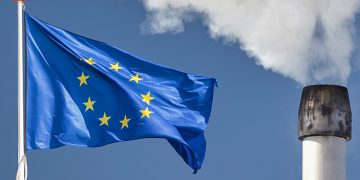ClassNK has released FAQs on the EU-ETS for Shipping, an overview and necessary preparation of the European Union Emissions Trading System (EU-ETS), which is expected to be introduced to the maritime industry.
The FAQs on the EU-ETS for Shipping report provides an overview of the EU-ETS for the shipping sector and the necessary preparations in a Q&A format to assist maritime stakeholders in their first efforts for the compliance with the EU-ETS. The nine questions are answered by the company as follows:
What is the EU-ETS?
The EU-ETS is the EU Emissions Trading System (ETS) introduced in 2005.
- Participating States
The EU-ETS is currently applicable to 30 States consisting of 27 EU Member States and 3 EEA States, namely, Norway, Iceland and Lichtenstein.
- Sectors in the scope of EU-ETS
The EU-ETS has been covering the energy-intensive sectors such as power generation, steel works, cement production and oil refineries since its launch in 2005. Its extension to the shipping sector is planned in January 2024.
- Cap-and-trade system
The EU-ETS works on the cap-and-trade system, which is to allocate allowances on the total amount of greenhouse gases (GHG) emissions that can be emitted by each operator or installation (cap), and to let them buy and sell their allowances in case of surplus or shortage (trade).
Such operators who exceed their allocated allowances must purchase the allowances from the designated markets or other operators. As cap levels are set to be gradually stringent, the efficient emissions reduction through the market principle is expected among the participants as a whole.
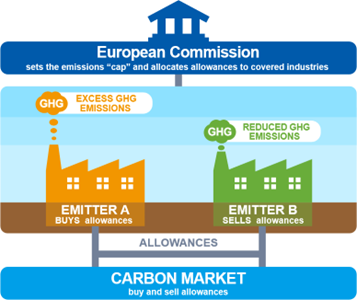
What is an overview of the EU-ETS for shipping?
- Emission allowances
There is no free allocation for the shipping sector. Shipping companies are required to purchase allowances based on their emissions.
- Responsibility
Shipping companies are responsible for the compliance with the EU-ETS for shipping.
- Ships in the scope
Ships of 5,000 GT and above, arriving at or departing from EU/EEA ports are in the scope of the EU-ETS for shipping, which is the same scope as the EU-MRV regulations
Greenhous gases (GHG) in the scope
- Until 2025: Carbon dioxide (CO2) only
- From 2026: Carbon dioxide (CO2) + methane (CH4) + nitrous oxide (N2O)
Emissions in the scope
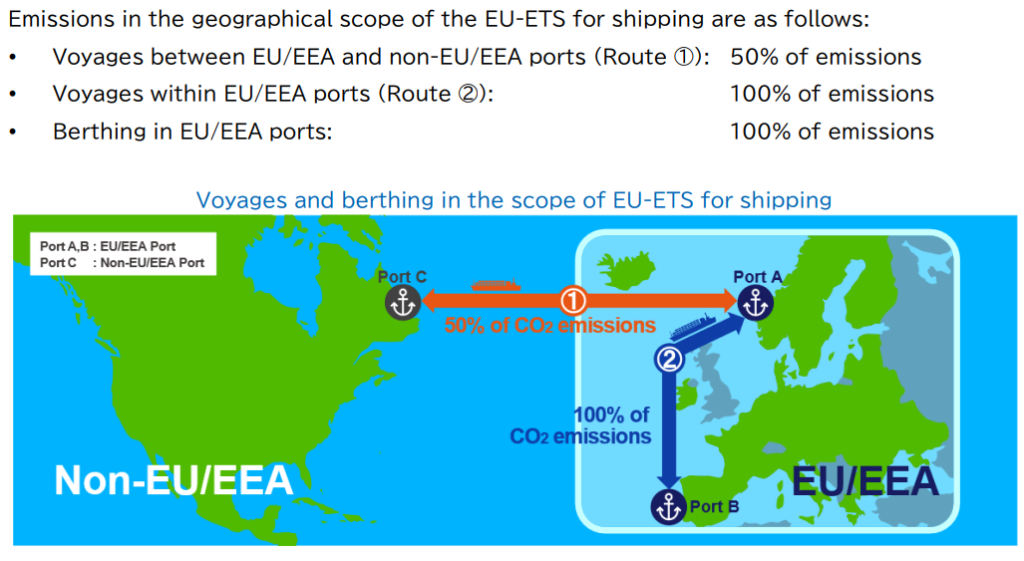
- Emissions in 2024 (surrendered in 2025) : 40% of the total emissions in the scope
- Emissions in 2025 (surrendered in 2026) : 70% of the total emissions in the scope
How can I check the GHG emissions?
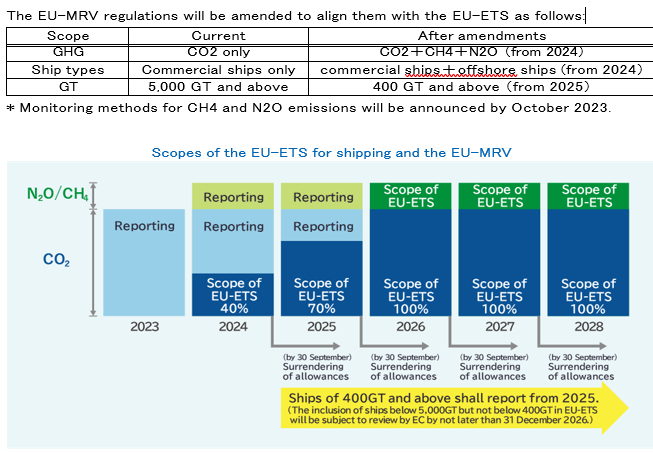
What is the EU-MRV regulations?
EU-MRV regulations means the Regulation (EU) 2015/757 of the European Parliament and of the Council of 29 April 2015 on the monitoring, reporting and verification of carbon dioxide emissions from maritime transport, and amending Directive 2009/16/EC requiring the monitoring, reporting and verification of fuel consumptions used onboard ships etc. during EU-related voyages which have been implemented from 2018. Ships of 5,000 GTs and above calling at EU ports are required to prepare a monitoring plan for their fuel consumptions and an emission report containing the records of their CO2 emissions for verification by an EU- accredited verifier.
What is the “port of call” under the EU-ETS for shipping?
Port of call is defined as:
- the port where a ship stops to load or unload cargo or to embark or disembark passengers,
- the port where an offshore ship stops to relieve the crew, considering that stops for the sole purposes of refuelling, obtaining supplies, relieving the crew of a ship other than an offshore ship,
- going into dry-dock or making repairs to the ship and/or its equipment,
- stops in port because the ship is in need of assistance or in distress,
- ship-to-ship transfers carried out outside ports,
- stops for the sole purpose of taking shelter from adverse weather or rendered necessary by search and rescue activities, and
- stops of containerships in a neighbouring container transhipment port listed in the implementing act adopted pursuant to Article 3g are excluded;
Stops of containerships in a neighbouring container transhipment port are excluded from the port of call under the EU-ETS for shipping, and the neighbouring container transhipment ports are neighbouring container transhipment ports where the share of transhipment of containers, measured in twenty-foot equivalent unit, exceeds 65% of the total container traffic of that port during the most recent twelve-month period for which relevant data are available located outside the Union but less than 300 nautical miles of a port under the jurisdiction of a Member State. It means that the voyages preceding and following such ports are considered as consecutive voyages.
By 31 December 2023, a list of such container transhipment ports will be established by the European Commission. Shipping companies may surrender 5% fewer allowances than their verified emissions taking place until 31 December 2030 from ice class ships having the ice-class IA or IA Super or an equivalent ice class.
What should I do for the EU-ETS for shipping?
- Step1: Registration to a competent authority
Under the EU-ETS for shipping, a shipping company performing EU related voyage(s) is registered to an administering authority of the EU/EEA Member States. As the registration is based on the following manner, a shipping company will not be able to change its administering authority.
- A shipping company registered in an EU/EEA Member State:
The administering authority of the EU/EEA Member State in which the shipping company is registered.
- A shipping company that is not registered in an EU/EEA Member State:
The administering authority of the EU/EEA Member State with the greatest estimated number of port calls from voyages performed by that shipping company in the last four monitoring years and falling within the scope of EU-ETS for shipping.
- Step 2: Update of ships’ monitoring plans (for the revised EU-MRV regulations)
Shipping companies should update monitoring plans for individual ships and, after obtaining their verifications, submit them to the administering authority concerned by 1 April 2024. The updated monitoring plan needs to contain the monitoring methods for CH4 and N2O emissions to be announced by October 2023.
- Step 3: Development and submission of emission reports for individual ships andaggregated emissions data at company level (under the revised EU-MRV regulations) Shipping companies should develop emission reports for ships applicable to the EU-MRV regulations for verification by a Shipping companies should then submit verified emission reports and aggregated emissions data at company level to the administering authority concerned by 31 March each year
- Step 4: Purchase and surrender of allowances
Shipping companies should purchase the allowances for the emissions in the scope in advance and surrender allowances based on the emissions reported to the administering authority as specified in Step 3 above by 30 September each year.
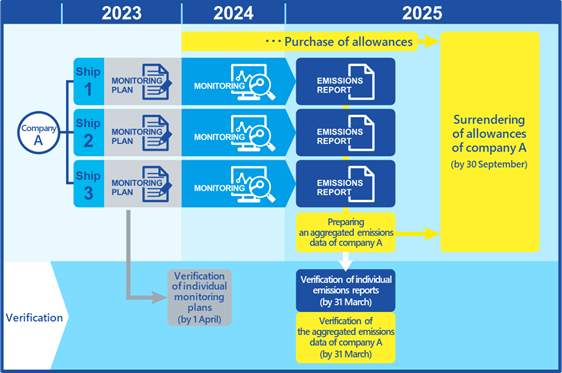
European Green Deal
The European Green Deal combines a comprehensive set of mutually reinforcing measures and initiatives aimed at achieving climate neutrality in the EU by 2050, and sets out a new growth strategy that aims to transform the Union into a fair and prosperous society, with a modern, resource-efficient and competitive economy, where economic growth is decoupled from resource use. The strategy includes a commitment to reduce EU’s economy-wide net greenhouse gas emissions by at least 55% by 2030 below 1990 levels.
FuelEU Maritime Proposal
The EU is considering the “FuelEU Maritime” proposal in addition to the EU-ETS for shipping. While the EU-ETS focuses on the GHG directly emitted from ships only, the FuelEU Maritime, expected to be introduced from 2025, covers the lifecycle GHG intensity of the fuels that ships used onboard, i.e. their production, transportation, storage and combustion on board.
Reference value for GHG intensity is reinforced every five years from 2020. In case of non- compliance with the reference value, penalty is imposed corresponding to the energy consumption exceeding the reference value. Mandating the use of onshore power supply in EU ports (from 2030) is also under consideration.
Who will purchase allowances under the EU-ETS for shipping?
Under the EU-ETS for shipping, the shipping company is responsible for the compliance with the regulation and defined as follows:
Shipping company means the shipowner or any other organization or person, such as the manager or the bareboat charterer, that has assumed the responsibility for the operation of the ship from the shipowner and that, on assuming such responsibility, has agreed to take over all the duties and responsibilities imposed by the International Management Code for the Safe Operation of Ships and for Pollution Prevention, set out in Annex I to Regulation (EC) No 336/2006 of the European Parliament and of the Council.
In addition to the above, EU/EEA Member States should take the necessary measures to ensure that when the ultimate responsibility for the purchase of the fuel and/or the operation of the ship is assumed by a different entity than the shipping company pursuant to a contractual arrangement, the shipping company is entitled to reimbursement from that entity for the costs arising from the surrender of allowances. “Operation of the ship” means determining the cargo carried and/or the route and the speed of the ship. It is to be noted that the shipping company still assumes the responsibility to ensure the compliance with the EU-ETS for shipping notwithstanding their entitlement for the reimbursement.
When, where, and how can I purchase/surrender allowances?
- How to purchase allowances
No free allocation is provided to the shipping sector. Allowances can be purchased through the European Energy Exchange (EEX) as the primary market. It can also be purchased through bilateral trades on the secondary market. Allowances can be purchased at any time, as long as they are secured by the due date for surrender each year.
- How and when to surrender allowances
Allowances should be surrendered by 30 September each year in accordance with the emissions in scope of the previous reporting year. The specific surrendering method for the shipping sector has not yet been clarified.
- Price of allowances
Price of allowances is determined by the supply/demand balance on the market. Necessary and proper adjustments are made by the EU to protect the market from insider trading and market operations. For the purchase through European Energy Exchange (EEX), price is determined through an auction. For the purchase on the secondary market, the trading is conducted between the parties concerned. Shipping companies need to understand in advance how many allowances are required to decide when to purchase them, for there may be a great price gap depending on the timing.
What are the penalties for non-conformities?
The EU-ETS sets the penalties to the shipping companies who are in breach of requirements to surrender sufficient allowances. Penalties for the shipping company are as follows:
- Publication of the names of shipping companies;
- The excess emissions penalty shall be EUR 100 for each tonne of carbon dioxide equivalent emitted for which the shipping company has not surrendered allowances. Payment of the excess emissions penalty shall not release the shipping company from the obligation to surrender an amount of allowances equal to those excess emissions when surrendering allowances in relation to the following calendar; and
- In the case of a shipping company that has failed to comply with the surrender requirements for two or more consecutive reporting periods and where other enforcement measures have failed to ensure compliance, the competent authority of the Member State of the port of entry may issue an expulsion order.
How are the revenues from the EU-ETS for shipping used?
Revenues from the EU-ETS for shipping are expected to be assigned to the Innovation Fund to support relevant projects for the penetration of fuels from renewable energy sources and low carbon fuels and to accelerate the innovation of low- or zero carbon technologies for the shipping sector.
EU-ETS for shipping and the IMO’s market-based measures
The revision of the Initial IMO Strategy on Reduction of GHG Emissions from Ships is under discussion in the IMO, and the adoption of the revision is expected at the 80th session of the IMO Marine Environment Protection Committee (MEPC 80) in July 2023. Global scheme for the GHG reductions through market-based measures, such as carbon levy and emissions trading, are also under consideration for international shipping.
When the IMO adopted the market-based measures, the European Commission will review the measures to ensure that any significant double burden is not placed on the shipping sector. If the IMO does not adopt a global market-based measure by 2028, further reinforcement of GHG emissions requiring the purchase of allowances (50% of the GHG emissions from the voyages between EU/EEA ports and non-EU/EEA ports) under the EU-ETS for shipping will be considered.

















